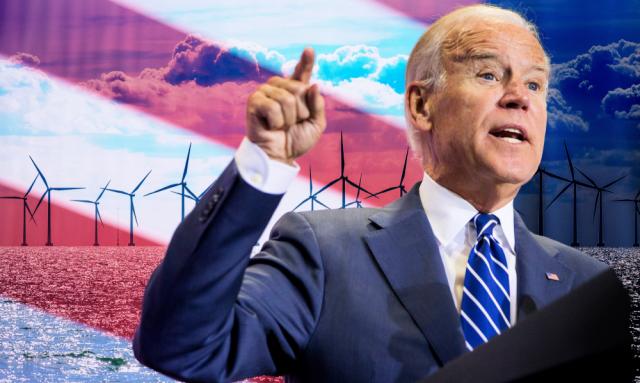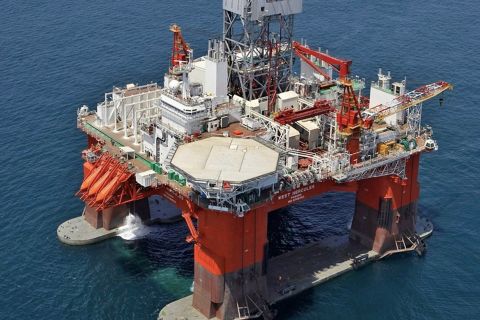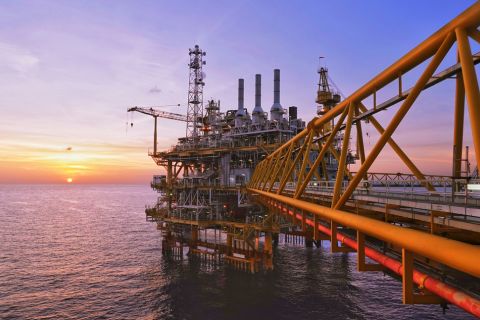
The Biden administration has refocused efforts to promote renewable energy development partially supported by grant and funding resource opportunities related to offshore wind announced in March 2021. (Source: Photo collage by Hart Energy; Image of Biden by NumenaStudios / Shutterstock.com)
Learn more about Hart Energy Conferences
Get our latest conference schedules, updates and insights straight to your inbox.
The next three years could be a defining period for the U.S. offshore wind sector as it represents a growth area of the maritime industry at both a domestic and international level.
Globally, developers have announced projects totaling at least 200 gigawatts (GW) of new capacity since the beginning of 2020, according to a report by RCG, which indicates that the active project portfolio for offshore wind developers now stands at 500 GW.
After a period of relatively slow progress, the U.S. government under the Biden administration has refocused efforts to promote renewable energy development with a goal of 25 GW of generating capacity installed by 2030, and to review more than a dozen lease area Construction and Operations Plans (COPs) by 2025. The growth potential of the U.S. market is further supported with the findings of a recent ABS poll, where nearly 90% of respondents believe offshore wind will play a significant role in sustainable U.S. energy strategy.

To support this ambitious activity, the White House announced in March 2021 that grant and funding resource opportunities related to offshore wind have been designated by the U.S. Department of Transportation Maritime Administration as well as the U.S. Department of Energy Loan Programs Office.
Getting to grips with the supply chain
Momentum is building, and stakeholders are accelerating their plans for engagement into the U.S. While the U.S. market waits for its first Jones Act-compliant turbine installation vessel, it needs to keep a watch on Europe, where the supply chain may also face vessel constraints. It is a critical time across the U.S. supply chain in which U.S. developers will need to rely on European suppliers that are already in high demand to begin to meet the U.S. government’s offshore wind plans.
Meeting the 2030 target will catalyze significant supply chain benefits, including:
- New port upgrade investments totalling more than $500 million;
- One to two new U.S. factories for each major windfarm component including wind turbine nacelles, blades, towers, foundations, and subsea cables;
- Additional cumulative demand of more than 7 million tons of steel—equivalent to four years of output for a typical U.S. steel mill; and
- Construction of four to six specialized turbine installation vessels in U.S. shipyards, each representing an investment between $250 million and $500 million.
Constructing and commissioning of a U.S.-flagged vessel is essential but concerns are being raised by offshore wind developers if they will face higher costs A U.S. vessel is unlikely to be built without the confidence that the vessel is used to full capacity and in most cases a vessel is likely to need 500 megawatt (MW) to 800 MW of annual capacity installation for at least five years in order to balance the books.
Is compliance a necessary hurdle in the expansion of the U.S. market?
Compared to the European offshore wind vessel market, the U.S. market is different. Firstly, there is the Merchant Marine (“Jones”) Act of 1920, which is a U.S. trade law that defines how maritime commerce is regulated.
Specific restrictions limit the transfer of cargo between U.S. ports to vessels that are registered and built in the U.S only. Ownership of these vessels must be by majority U.S. incorporated entities with U.S. citizen representation. Onboard vessel crews may use only United States Coast Guard (USCG) credentialed mariners and a majority of U.S. citizens.
In 2016, the commissioning of a U.S. offshore project–Deepwater Wind’s 30 MW Block Island wind farm–located near the Rhode Island coast, illustrates the challenge which current U.S. operators face. With a lack of US vessels, developers contracted a vessel from Europe, but the Jones Act meant that the vessel was prohibited from entering U.S. shores to collect and transport wind turbines, towers, and blades. To overcome this issue, smaller U.S.-flagged liftboats were used that delivered wind turbine equipment out to the site, where it was transferred to the European jack-up vessel, which inevitably increased the cost and complexity of the project.
While the U.S. Customs and Border Protection agency (CBP) holds ultimate responsibility for making rulings on whether a specific trade activity is subject to the Jones Act, the USCG determines whether a vessel is U.S. built and therefore eligible for Jones Act trade. USCG has determined that ‘U.S. built’ can be achieved if all major components of a vessel’s hull and superstructure are fabricated in the U.S. and the vessel is assembled entirely in the U.S.
Companies outside of the U.S. that form the supply chain, including component manufacturers for engines, propellers and certain hull elements are not included.
Construction of a vessel to U.S. standards and certification by USCG may be achieved outside of the U.S. for international trade but it is not eligible for Jones Act designation unless specifically permitted via a formal waiver process. Presently, waivers are rare and typically granted for national defense or emergency justifications.
A 12-point guide
More dedicated vessels are essential for the future success of the U.S. offshore wind market, and a global supply chain can help the U.S. offshore wind market to flourish. In a fresh look at the ‘here and now’ situation, a detailed assessment and awareness of the compliance and safety requirements of a vessel and its crew are provided in a new industry report released by ABS, which highlights:
- How does the Jones Act impact offshore wind support vessels?
- What are the central elements of U.S. regulations for vessel design, construction and operation?
- Which departments are responsible for maritime safety?
- Can vessel designs previously approved by other Flag authorities in accordance with IMO and with International Standards be considered?
- How are wind turbine technicians, offshore workers and crew viewed in U.S. regulation?
- What are minimal safe manning requirements?
- What are the primary distinguishing crew licensing elements for U.S. registered vessels?
- Are there unique U.S. requirements for vessel stability?
- What are the certification and registration requirements for a vessel in U.S. operations?
- How are U.S. regulations applied for diesel engines in small workboats?
- What are the implications for crew transfer vessels?
- What are the requirements for crew berthing conditions and onboard design considerations?
Is a change of mindset on the horizon?
There is no question. Change has to happen. As the industry begins to expand and country decarbonization targets need to be met, construction and maintenance of offshore wind projects calls for a combination of expertise that is comparatively new to the U.S. market and requires a variety of specialist support tonnage.
A dedicated U.S.-flagged installation vessel will be efficient and cost-effective by loading all components at a U.S. port on one vessel. To use a foreign, non-Jones Act installation vessel, components from a U.S. port must be transported by a U.S. built feeder vessel. Other wind support vessels such as a Service Operation Vessel (SOV), floating heavy-lift vessel, and Crew Transfer Vessel (CTV) operating in U.S. offshore wind farms are also required to comply with the U.S. regulations.
However, what is clear is that members of the maritime world and the offshore wind industry at large, need to increase their dialogue and collaborative efforts, and fast, to drive forward the required development of the U.S. offshore wind market to reach the Biden administration’s offshore wind targets. But action is needed now—not tomorrow.
About the Author:
Matthew Tremblay serves as ABS Senior Vice President of Global Offshore Markets, based at ABS corporate headquarters in Houston. In his current role, Tremblay holds the global responsibility for strategic planning and client development within the offshore market sector.
Throughout his 23-year tenure at ABS, Tremblay has served in various engineering and leadership positions throughout the U.S. and Asia, including Pacific division vice president of operations based in Singapore and vice president of engineering for the ABS Americas division.
Tremblay graduated from the Massachusetts Maritime Academy, with a Bachelor’s degree in Marine Engineering. He is also a member of the American Society of Naval Architects and Marine Engineers (SNAME).
Recommended Reading
US Drillers Add Oil, Gas Rigs for Second Week in a Row
2024-01-26 - The oil and gas rig count, an early indicator of future output, rose by one to 621 in the week to Jan. 26.
Second Light Oil Discovery in Mopane-1X Well
2024-01-26 - Galp Energia's Avo-2 target in the Mopane-1X well offshore Namibia delivers second significant column of light oil.
CNOOC Sets Increased 2024-2026 Production Targets
2024-01-25 - CNOOC Ltd. plans on $17.5B capex in 2024, with 63% of that dedicated to project development.
E&P Highlights: Jan. 29, 2024
2024-01-29 - Here’s a roundup of the latest E&P headlines, including activity at the Ichthys Field offshore Australia and new contract awards.
Seadrill Awarded $97.5 Million in Drillship Contracts
2024-01-30 - Seadrill will also resume management services for its West Auriga drillship earlier than anticipated.




